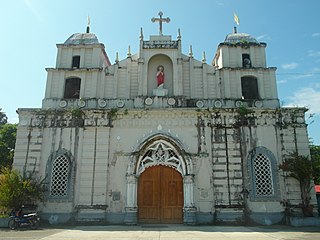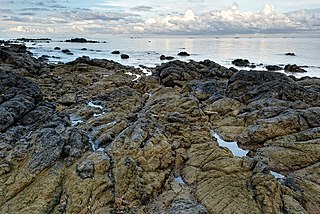
Aklan, officially the Province of Aklan, is a province in the Western Visayas region of the Philippines. Its capital is Kalibo. The province is situated in the northwest portion of Panay Island, bordering Antique to the southwest, and Capiz to the southeast. Aklan faces the Sibuyan Sea and Romblon province to the north.

Western Visayas is an administrative region in the Philippines, numerically designated as Region VI. It consists of six provinces and two highly urbanized cities. The regional center is Iloilo City. The region is dominated by the native speakers of four Visayan languages: Hiligaynon, Kinaray-a, Aklanon and Capiznon. The land area of the region is 20,794.18 km2 (8,028.68 sq mi), and with a population of 7,954,723 inhabitants, it is the second most populous region in the Visayas after Central Visayas.

Malinao, officially the Municipality of Malinao, is a 4th-class municipality in the province of Aklan, Philippines. According to the 2020 census, it has a population of 24,517 people.

Kalibo, officially the Municipality of Kalibo, is a first-class municipality and capital of the Province of Aklan, Philippines. According to the 2020 census, it has a population of 89,127 people.

Altavas, officially the Municipality of Altavas, is a 4th class municipality in the province of Aklan, Philippines. According to the 2020 census, it has a population of 25,639 people.

Balete, officially the Municipality of Balete, is a 4th class municipality in the province of Aklan, Philippines. According to the 2020 census, it has a population of 30,090 people.

Batan, officially the Municipality of Batan, is a 4th class municipality in the province of Aklan, Philippines. According to the 2020 census, it has a population of 33,484 people.

Ibajay, officially the Municipality of Ibajay, is a 3rd class municipality in the province of Aklan, Philippines. During the creation of Aklan Province in 1956, Ibajay was its biggest municipality in terms of population. According to the 2020 census, it has a population of 52,365 people, making it the third most populated town in Aklan.

Lezo, officially the Municipality of Lezo, is a 5th class municipality in the province of Aklan, Philippines. It is the smallest municipality in the province both by population and by land area, and even by revenue. According to the 2020 census, it has a population of 15,639 people.

Libacao, officially the Municipality of Libacao, is a 3rd class municipality in the province of Aklan, Philippines. According to the 2020 census, it has a population of 28,272 people.

Makato, officially the Municipality of Makato, is a 4th class municipality in the province of Aklan, Philippines. According to the 2020 census, it has a population of 29,717 people.

Malay, officially the Municipality of Malay, is a 1st class municipality in the province of Aklan, Philippines. It is the richest municipality in the province in terms of revenue. According to the 2020 census, it has a population of 60,077 people, making it the second most populous municipality in Aklan. It is the northernmost town on the island of Panay and the youngest amongst all municipalities in Aklan province. The resort island of Boracay is part of the municipality.

Nabas, officially the Municipality of Nabas, is a 4th class municipality in the province of Aklan, Philippines. Nabas serves as the arrival gateway of Boracay Airport. According to the 2020 census, it has a population of 40,632 people, making it the fifth most populous town in Aklan Province..

New Washington, officially the Municipality of New Washington, is a 3rd class municipality in the province of Aklan, Philippines. According to the 2020 census, it has a population of 47,955 people.

Numancia, officially the Municipality of Numancia, is a 4th class municipality in the province of Aklan, Philippines. Because of its proximity to the Capital Town of Kalibo, majority of its baranggays are classified as urbanized making the municipality the second most densely populated municipality in the province with 1,200 inhabitants per square kilometres. According to the 2020 census, it has a population of 35,693 people.

Tangalan, officially the Municipality of Tangalan, is a 5th class municipality in the province of Aklan, Philippines. According to the 2020 census, it has a population of 23,704 people.

Pulupandan, officially the Municipality of Pulupandan, is a 3rd class municipality in the province of Negros Occidental, Philippines. According to the 2020 census, it has a population of 30,117 people.

Pandan, officially the Municipality of Pandan, is a 3rd class municipality in the province of Antique, Philippines. According to the 2020 census, it has a population of 35,965 people. Making it 7th most populous municipality in the province of Antique.

Sapian, officially the Municipality of Sapian, and sometimes spelled Sapi-an, is a 4th class municipality in the province of Capiz, Philippines. According to the 2020 census, it has a population of 26,697 people, making it the least populated municipality in the province. It is 27 kilometres (17 mi) from Roxas City, the provincial capital.

San Jose, officially the Municipality of San Jose, is a 5th class municipality in the province of Romblon, Philippines. According to the 2020 census, it has a population of 11,759 people.

























